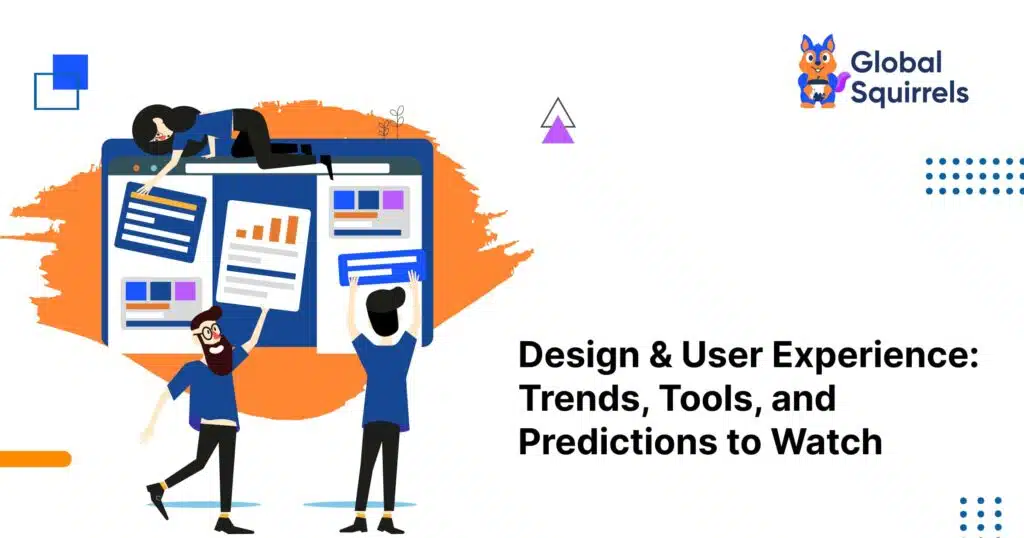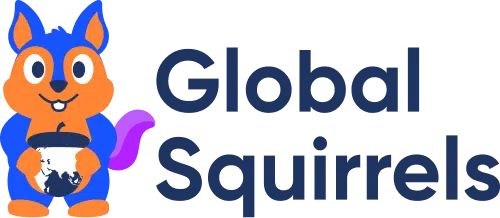Design & User Experience: Trends, Tools, and Predictions to Watch

Products developed to catch the attention of the users. Therefore, design and user experience go side-by-side. Developers and companies impress the users by providing solutions to their pain points so that the users get the necessary assistance while using the products or the services.
This blog will show you the future of design and user experience and how the trends and tools evolve with the users’ needs.
First, Let’s understand the design and UX and the impact on the users’ daily lives.
What are the design and user experience – the impact on users
Design and User Experience (UX) are crucial in how users interact with and perceive products, whether websites, applications, or physical products. The impact of Design and UX on users is multifaceted and significant:
Usability
Good design and UX make products accessible and intuitive to use. This means less time spent figuring out how to use a product and more time using it effectively. Improved usability leads to higher user satisfaction and better overall experiences.
Accessibility
Inclusive design and UX consider the diverse needs of users, including those with disabilities. Accessible design ensures that a broader audience can use the product comfortably and efficiently, which is ethically essential and expands the user base.
Engagement
Engaging design keeps users interested and involved. A well-designed interface can encourage users to explore more features and spend more time with a product. This can lead to increased user engagement and loyalty.
Brand perception
The design of a product significantly affects the perception of the brand behind it. A sleek, modern design can convey a sense of professionalism and innovation, while a clumsy or outdated design might give an impression of negligence or irrelevance.
User trust and credibility
Users are more likely to trust and feel comfortable with a product with a professional and aesthetically pleasing design. This trust is crucial, especially for e-commerce sites or any digital product that handles user data.
Error reduction
A well-thought-out UX design can reduce user errors. By guiding users through processes and preventing mistakes before they happen, a good design can enhance the overall effectiveness and efficiency of user interaction.
Conversion rates
In the context of websites and apps, sound design and UX can lead to higher conversion rates. This means more users completing desired actions, such as signing up, purchasing, or downloading content.
Customer satisfaction and retention
A positive user experience leads to higher customer satisfaction. Satisfied users are more likely to return, recommend the product to others, and have a higher overall lifetime value to the company.
Cost efficiency
Investing in good design and UX upfront can save costs in the long run by reducing the need for extensive redesigns, customer support, and dealing with usability issues.
Emotional connection
Design can evoke emotions and create a connection with the user. A product that delights and resonates emotionally can foster a robust user-product relationship.
Design and UX are not just about aesthetics; they are about creating products that are enjoyable, easy to use, accessible, and effective. The impact of these elements on users is profound, influencing everything from user satisfaction to the bottom line of businesses.
The future trends, tools and predictions of design and UX
The design and user experience field continuously evolves, driven by technological advancements, user expectations, and cultural shifts. Here are some of the trends, tools, and predictions that have been shaping the industry:
Trends in design and user experience
Inclusive and accessible design
There’s an increasing focus on creating accessible designs for all users, including those with disabilities. This includes using color contrasts effectively, designing for screen readers, and ensuring ease of navigation for everyone.
Emphasis on user privacy
With growing concerns about data privacy, UX design is increasingly incorporating features that emphasize user privacy, transparency, and control over personal data.
Voice user interfaces (VUIs)
As voice technology becomes more sophisticated, designing for voice interactions is becoming more prevalent. This includes considering how users interact with voice assistants and smart devices.
Augmented reality (AR) and virtual reality (VR)
AR and VR are integrated into user experiences, offering immersive and interactive environments. This trend is particularly notable in gaming, education, and retail.
Sustainable design
There’s a growing awareness of the environmental impact of digital products. Sustainable design focuses on reducing digital carbon footprints and promoting eco-friendly practices.
Minimalist and functional aesthetics
Minimalist design focusing on functionality and user-friendliness continues to be popular, as it helps users focus on essential content without unnecessary distractions.
The tools used in design and user experience
Figma and sketch
These tools are widely used for UI/UX design, offering collaborative features and a wide range of functionalities for creating detailed plans and prototypes.
Adobe xd
Known for its seamless integration with other Adobe products, XD is a powerful tool for wireframing, designing, and prototyping.
InVision
A tool that provides a platform for prototyping, collaboration, and workflow management. It’s beneficial for team collaboration.
Axure RP
Known for its high-fidelity prototypes and comprehensive feature set, Axure is a staple for many UX professionals.
UXPin
Offers advanced prototyping with code components, logic, states, and design systems.
Predictions of design and user experience
AI and machine learning in design
AI tools are expected to be more significant in assisting design processes, from auto-generating layouts to providing user insights through data analysis.
Increased use of micro-interactions
Micro-interactions, which are small animations or effects in response to user actions, will likely become more prevalent for enhancing user engagement and providing feedback.
Greater focus on mental well-being
Designing for mental well-being will likely become more prominent, with apps and interfaces incorporating elements that promote mindfulness, reduce stress, and encourage digital detox.
Cross-platform consistency
As users engage with products across multiple platforms, there will be a greater need for consistent and seamless user experiences across all devices and platforms.
Growth in remote collaboration tools
The remote work trend is expected to continue influencing designers’ and teams’ need for more effective and efficient online collaboration tools.
These trends, tools, and predictions indicate that the field of design and UX is moving towards more inclusive, sustainable, and technologically integrated experiences.
The subdomains of design and user experience detail –
If design and UX play a significant role in customer satisfaction, it’s the contribution of the subdomains that help achieve the targets. Let’s learn about the subdomains:
UX designers
A User Experience (UX) Designer is a professional who specializes in creating meaningful and relevant experiences for users of a product, such as a website, application, or any interactive system. Companies hire UX designers to ensure that the product is not only functional and accessible but also enjoyable and easy to use.
Graphic designers
Graphic Designers specialize in creating visual content to communicate messages. They use various design elements such as typography, imagery, color, and layout to create visually appealing and effective designs. Organizations hire Graphic designers to add value in advertising, branding, web design, and publishing.
Architectural Draftsmen
An Architectural Draftsman, or a Drafter or Draftsperson, specializes in creating technical drawings and plans for construction and architectural projects.
Organizations hire Architectural draftsmen to guide the construction of structures such as buildings, bridges, and other infrastructures.
The talent pool in design and UX is diverse, and talented professionals added value to enhance the user experiences of applications, systems, and many other digital and complex products.
Remote employees are, therefore, an asset for any organization that provides design and UX services.
How are remote design and user experience employees more beneficial?
Remote design and user experience employees offer several benefits that can be particularly advantageous for organizations. Here are some of the key ways in which remote design and UX professionals can be more beneficial:
Access to a wider talent pool
Remote work allows companies to hire the best talent regardless of their geographical location. This can be especially beneficial in fields like design and UX, where specific skills or expertise might be scarce in the company’s local area.
Diverse perspectives
A team of designers and UX professionals from various backgrounds and locations can bring diverse perspectives to a project. This diversity can lead to more creative solutions and designs that cater to a broader audience.
Flexibility and productivity
Remote employees often have the flexibility to work during their most productive hours, which can vary from person to person. This flexibility can lead to higher productivity and better quality of work.
Cost efficiency
Employers can save on costs related to physical office space, utilities, and other resources typically required for onsite employees. For employees, it can mean savings on commuting, work attire, and other related expenses.
Improved work-life balance
Remote work can provide employees a better work-life balance, reducing stress and improving overall job satisfaction. Happier employees are often more motivated and engaged, leading to better performance.
Reduced turnover
The benefits of remote work can lead to higher employee retention rates. The reduced stress and improved balance can make employees less likely to seek opportunities elsewhere.
Extended work coverage
With remote employees located in different time zones, a company can extend its hours of operation. This can be especially beneficial for teams that need to collaborate with clients or colleagues in other parts of the world.
Agility and scalability
Remote teams can be more agile and more scale-accessible. As business needs change, it’s often simpler to onboard or offboard remote employees than those working in an office setting.
Innovation in collaboration tools
Remote work necessitates the innovative use and adoption of digital collaboration tools. This can lead to more efficient workflows and processes, benefiting onsite workers.
Environmentally friendly
Remote work reduces the need for commuting, which can significantly lower carbon emissions. This contributes to a company’s sustainability goals and corporate social responsibility.
If you want to hire remote employees, sign up with our staffing platform and avail yourself of all the remote hiring benefits. Let’s learn more about the platform.
How does Global Squirrels help in remote hiring design and user experience professionals?
Global Squirrels is a one-stop solution for remote hiring. The platform eases the hassles of remote hiring and helps access your organization’s global talent pool.
With hiring, the solution also helps in payroll management. The platform assists in calculating compensation, managing leave and benefits sheets, tax calculations, compliance based on international laws, etc.
Request a demo and avail of all the assistance your organization requires.
Why do you sign up with Global Squirrels?
The platform assists in multiple ways to make global hiring faster and smoother. Sign up with Global Squirrels and get many benefits, including:
- You do not need to set up any entity to hire local professionals
- There is no need to pay bloated markups or agency fees
- You only need to pay the flat license fee per hire
- You can access the global talent pool
- You can avail of assistance in compliance based on international laws
- You can also help in payroll management
Based on your job requirements we have various pricing plans you can choose from there
In Conclusion
The design and user experience become an integral part of the product development team. With the development of technology and innovation, there are many opportunities to reach out to users to solve their issues through products and services. If you want to hire remote design and user experience professionals to build your design team, sign up with Global Squirrels.
